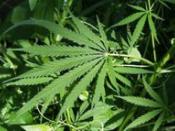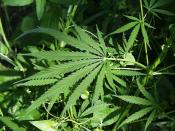Marijuana is the name for several breeds of the Cannibus sativa l. plants. This plant most commonly seen on the evening news, the drug is Delta-9-tetrahydocannabinol (THC) and I refer to the plant as "Mary Jane". Typically Mary Jane is extremely short, produces very poor fibers, and has high THC concentration in its buds. Hemp plants, Mary Jane's brothers, are distinguished by towering over thirteen feet high, poor production of THC, and exceptionally strong fibers. Hemp is a largely ignored plant because of the bad rap that its sister gets as a vice, generated by energy, legal and illegal drug, and paper industries; all of these industries are threatened by the industrialization of marijuana. I ask you to now read on to what I have to say with an open mind and a closed mouth.
It would be paranoid to say that energy companies are out to get marijuana; however, if the legislature were to begin programs that would give rise to biomass fuel, which would include hemp production for a number of reasons, the fossil-fuel industry would be threatened.
Biomass energy is basically the burning of pre-petrol hydrocarbons (plants and animals) in the three forms of fossil fuels: solid (i.e. coal, etc.), liquid (crude oil), and gas (natural gas). Fossil fuel energy companies, in an attempt to argue the case out, will say that burning biomass releases just as many greenhouse-gasses as fossil fuels. This is true, however the burning of biomass doesn't damage as much because plants that produce this energy will take in these greenhouse-gases. This cycle balances out in the long run, meaning that the damage done by oil spills and industrial burning can be avoided and make the western world less dependant on foreign fossil fuels.
All plants use photosynthesis to supply themselves with fructose,


